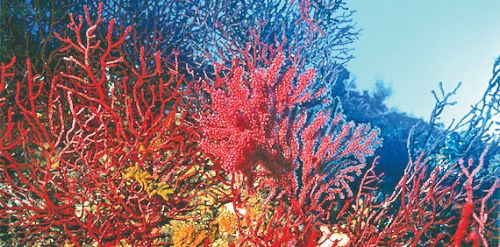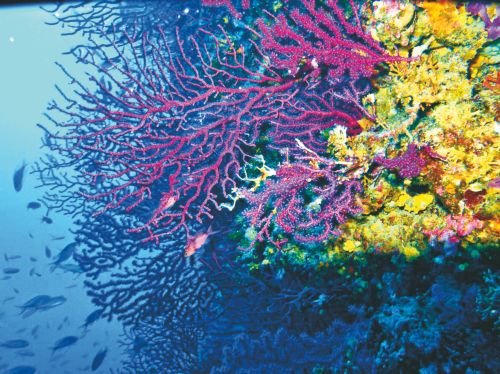Filenews 17 August 2025 - by Florence Kythreotou
The first image that comes to mind when we hear the word coral is often a red branch jewellery. Or a pattern on a summer dress or a tablecloth, inspired by exotic travel. Rarely – almost never – do we not think that the seabed of Cyprus has its own corals. They may not be as spectacular as the tropics, but they are precious! And if you observe them with sensitivity, then they are also wonderful, colourful, complex – like Fauve's works of art with the boldness of colour and the vibrancy of form.
The bottom of the Cypriot Sea is home to coral organisms such as Cladocora caespitosa – the only hard coral in the Mediterranean that forms colonies. At depths from 1 to 17 meters, it creates cushion-like structures that become a shelter for fish, shrimps, crustaceans and microorganisms. Next to it, soft corals, mergons, sponges and rare polyps compose a seabed that has nothing to envy from tropical paradises – except perhaps the recognition it deserves.
Our sea is home to these corals in Cape Greco, Ayia Napa and Paphos. And yet, most of us don't even know that they exist.

Does the planet send out SOS too?
David Obura, a leading marine biologist and head of the international scientific platform IPBES (Intergovernmental Science-Policy Platform on Biodiversity and Ecosystem Services), in a recent interview with the Guardian newspaper, spoke about the silent global collapse of coral ecosystems. He described it as "death from a thousand plagues": small pressures that, cumulatively, lead to the disintegration of complex marine worlds.
Although he spoke mainly about the Pacific, the Caribbean and the Persian Gulf, his warnings resonate clearly in the Mediterranean as well. The same causes that are disappearing reefs in Jamaica and Mozambique – overheating, pollution, overfishing, acidification – are already at work in our own seas.
The marine heatwaves recorded by scientists in recent years in the waters of Cyprus have caused mass deaths of Cladocora colonies, reducing biodiversity and disrupting critical food relationships. Cyprus is also affected by less visible threats, such as invasive (or invasive) species that come through Suez and feed on local corals, intensifying ecological pressure.

An invisible disaster and a hidden beauty
The worst thing is that this loss is not felt. Not even by those who dive. The corals of Cyprus are not spectacular, they are not Instagrammable. They are small, difficult to detect, silent. But that doesn't mean they're not gorgeous and valuable.
Their collapse removes the three-dimensional structure of the seabed, reduces food chains, and ultimately deprives the sea of its own functions. We are not just talking about ecological damage. We are also talking about economic, fishing, tourism and – yes – aesthetics.
What is happening in Cyprus?
Despite the lack of broad information, the scientific community has already been activated:
- The Cyprus Marine and Maritime Institute CMMI is leading a pilot program for the replanting of Cladocora caespitosa with floating coral nurseries off Cape Greco and Ayia Napa. This project is part of the European project EFFECTIVE, in which CMMI is leading Pilot 4 for the restoration of endemic coral in the southeastern Mediterranean.
- The Marine and Environmental Research Laboratory of CUT participates in monitoring programs of Cladocora and other coral organisms, utilizing underwater cameras and temperature sensors.
However, all of this remains almost invisible to the general public. However, we don't have to be scientists or environmentalists to be moved. As long as we know that something beautiful, complex and rare is happening under the surface of our sea. And that, if it is lost, it will be a silent impoverishment of our country. David Obura put it another way: "We have been using nature for free for centuries." Maybe now it's time to give it something back. Perhaps we do not need to repay it with grandiose acts. It is enough, perhaps, to start observing it.
